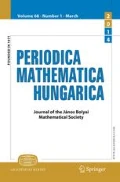Abstract
In the applications it may occur that our initial pseudorandom binary sequence turns out to be not long enough, thus we have to take the concatenation or merging of it with other pseudorandom binary sequences. Here our goal is study when we can form the concatenation of several pseudorandom binary sequences belonging to a given family? We introduce and study new measures which can be used for answering this question.
Similar content being viewed by others
References
R. Ahlswede, L.H. Khachatrian, C. Mauduit and A. Sárközy, A complexity measure for families of binary sequences, Period. Math. Hungar., 46 (2003), 107–118.
R. Ahlswede, C. Mauduit and A. Sárközy, Large families of pseudorandom sequences of k symbols and their complexity, Part I, Part II, General Theory of Information Transfer and Combinatorics, Lecture Notes in Computer Science, Vol. 4123, Springer Verlag, 293–307.
V. Anantharam, A technique to study the correlation measures of binary sequences, Discrete Math., to appear.
M. Ben-Or, Probabilistic algorithms in finite fields, 22nd Annual Symposium on Foundations of Computer Science, IEEE, New York, 1981, 394–398.
J. Cassaigne, C. Mauduit and A. Sárközy, On finite pseudorandom binary sequences VII: The measures of pseudorandomness, Acta Arith., 103 (2002), 97–118.
E. Galois, Sur la théorie des nombres, Écrits et Mémoires Mathématiques d’Évareste Galois, (R. Bourgne and J.-P. Arza eds.), Gauthier-Villars, 1830, 112–128.
L. Goubin, C. Mauduit and A. Sárközy, Construction of large families of pseudorandom binary sequences, J. Number Theory, 106 (2004), 56–69.
K. Gyarmati, A note to the paper “On a fast version of a pseudorandom generator”, Ann. Univ. Sci. Budapest. Eötvös Sect. Math., 49 (2006), 87–93.
K. Gyarmati, On a family of pseudorandom binary sequences, Period. Math. Hungar., 49 (2004), 45–63.
K. Gyarmati, On a fast version of a pseudorandom generator, General Theory of Information Transfer and Combinatorics, Lecture Notes in Computer Science, Springer, Berlin — Heidelberg, 2006, 326–342.
K. Gyarmati, A. Sárközy and A. Pethő, On linear recursion and pseudorandomness, Acta Arith., 118 (2005), 359–374.
J. Rivat and A. Sárközy, Modular construction of pseudorandom binary sequences with composite moduli, Period. Math. Hungar., 51 (2005), 75–107.
C. Mauduit, J. Rivat and A. Sárközy, Construction of pseudorandom binary sequences using additive characters, Monatsh. Math., 141 (2004), 197–208.
C. Mauduit and A. Sárközy, On finite pseudorandom binary sequence I: Measures of pseudorandomness, the Legendre symbol, Acta Arith., 82 (1997), 365–377.
E. H. Moore, A doubly-infinite system of simple groups, Bull. Amer. Math. Soc., 3 (1893), 73–78.
M. O. Rabin, Probabilistic algorithms in finite fields, SIAM J. Comput., 9 (1980), 273–280.
L. Rédei, Algebra, Pergamon Press, Oxford — New York — Toronto Ont., 1967.
V. Shoup, Fast construction of irreducible polynomials over finite fields, J. Symbolic Computation, 17 (1994), 371–391.
V. Tóth, Collision and avalanche effect in famillies of pseudorandom binary sequences, Period. Math. Hungar., 55 (2007), 185–196.
A. Weil, Sur les courbes algébriques et les variétés qui s’en déduisent, Actualités Sci. Ind. 1041, Hermann, Paris, 1948.
Author information
Authors and Affiliations
Corresponding author
Additional information
Communicated by Attila Pethő
Research partially supported by Hungarian NFSR, Grants No. K49693, K67676, K72264 and the János Bolyai Research Fellowship.
Rights and permissions
About this article
Cite this article
Gyarmati, K. Concatenation of pseudorandom binary sequences. Period Math Hung 58, 99–120 (2009). https://doi.org/10.1007/s10998-009-9099-x
Received:
Accepted:
Published:
Issue Date:
DOI: https://doi.org/10.1007/s10998-009-9099-x




